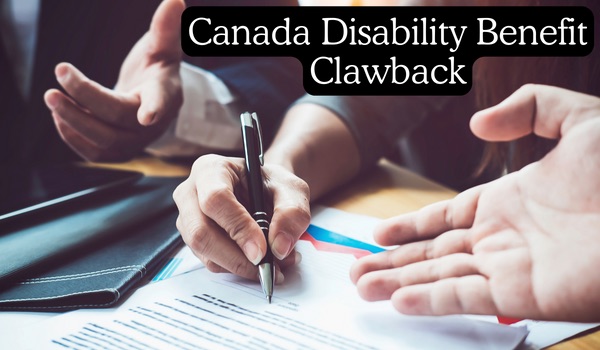Canada Disability Benefit Clawback Bill C-22, also known as the Canada Disability Benefit, was enacted to provide financial assistance to low-income disabled Canadians of working age. Despite the lack of information on eligibility requirements and benefit amounts, disability campaigners are celebrating this development. The passing of this law is timely as many Canadians with disabilities are currently experiencing financial hardships, to the extent that some are considering medical assistance in dying. Long-term disability benefits are a crucial part of Canada’s social safety net, with over 8.8 billion in benefits paid out in 2021, accounting for 20% of all benefits spent in the country. To learn more about the Canada Disability Benefit Clawback and who may face it, you can visit the relevant page.
Canada Disability Benefit Clawback
The Canada Disability Benefit was enacted into law in 2023 after facing multiple years of postponement. Apart from existing provincial and territorial financial aids and other income streams, the aim of the program is to provide additional income to improve the lives of disabled individuals, rather than replacing their existing income. It does not constitute earnings from employment. The Canada Disability Benefit is designed to help alleviate poverty among disabled Canadians and will be advantageous to over 22% of working-age people with disabilities who are living in poverty.
What is Canada Disability Benefit?
- The Canada Pension Plan is a national public insurance scheme that protects workers’ incomes from extended wage disruptions due to retirement, illness, or death. Individuals who cannot work because of a severe disability receive payments through the disability benefit program.
- The CPP provides a flat-rate benefit to children of disability beneficiaries, which is not commonly available through other income security programs or private insurance. The CPP disability benefit offers various important advantages and extends disability coverage to all employed Canadians, including those who are self-employed and ineligible for workers’ compensation or employment insurance.
- The CPP does not increase premiums for contributors deemed high risk, and it does not bar workers based on their medical history. It modifies benefit calculations to include certain disability-related expenses through a fixed-rate element. Coverage is offered until retirement, recovery from disability, or death. Unlike most private insurances, the CPP guarantees full inflation protection.
Who Can Face a Disability Benefit Clawback in Canada?
A contractual provision called a clawback requires that funds previously given to an employee be reimbursed to their employer or beneficiary, sometimes with added interest. Clawback clauses are commonly included in employee contracts for incentive-based compensation, like bonuses, especially in the financial sector. Most clawback clauses are non-negotiable. In the case of beneficiaries of Canada Pension Plan Disability, a clawback provision may apply if required information or documentation is not provided. When individuals encounter clawback-related issues, the funds are typically reclaimed, and CRA officials reach out to the public to assist them in understanding the process.

Who is Eligible for disability benefits in Canada?
The benefits provided by the Canada Pension Plan Disability (CPPD) are designed to assist eligible CPP contributors under 65 who experience a severe and prolonged disability, as outlined in the Canada Pension Plan legislation, in replacing a portion of their income. The CPPD program has two eligibility requirements:
- First, candidates must have contributed to the program for four of the previous six years, with minimum earnings requirements in each of these years; for those who have contributed for 25 years or more, the need is for three of the previous six years.
- The second requirement is that they have to show that their physical or mental impairment keeps them from working consistently at any profession that is significantly profitable, that the impairment is long-term and unending, or that it is likely to be fatal.
CRA- Examples of Clawback Provisions
Numerous instances exist of the federal government, insurance companies, and businesses implementing clawbacks. The following are some of the most common clawback clauses in use today:
- Executive compensation: Clawbacks may be applied in the event that an executive violates a contract, mishandles confidential information, or joins a rival company.
- Life insurance: A clause may specify that in the event of cancellation, the policy must be returned and payments made.
- Dividends: These may be reclaimed in some situations.
- Contracts with the government: If certain conditions are not fulfilled, contractors may face clawbacks.
- Medicaid: Medicaid is able to recoup any costs incurred for providing post-death care for a Medicaid recipient.
- Pensions: In the event that a pensioner is found to have committed fraud or misused information, the pension may be reclaimed by the company.
Conclusion
Navigating the Canada Disability Benefit Clawback can be a daunting task, but understanding the ins and outs of this system is crucial to ensuring you receive the benefits you deserve. While facing a CDB clawback can be challenging, there are steps you can take to minimize its impact on your financial situation. By staying informed, seeking professional advice, and advocating for your rights, you can navigate this complex system with confidence. Remember, you are not alone in this journey, and there are resources available to support you. Whether it’s reaching out to disability advocacy groups or consulting with a knowledgeable attorney, don’t hesitate to seek the help you need. Together, we can work towards a fairer and more inclusive system that supports individuals with disabilities in Canada.